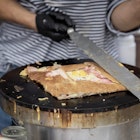

Brussels Beer Project is just one of the breweries experimenting in Belgium's capital right now © Analia Glogowski/Lonely Planet
Even before a drink, the figures are staggering: in a country of 11 million inhabitants, there are more than 260 breweries in Belgium, conjuring and concocting anywhere between 500 and 2000 different beers at any time.
So while it might be easy to get a beer in Brussels, it’s hard to know where to begin – fortunately, the city’s edifying museums, historical bars and carefully-crafted brewery tours can help. Here’s everything you’ve ever wanted to know about beer in the Belgian capital, but were too tipsy to ask.
A brief history of Belgian beer
No other country can pride itself on such a sheer variety of beer styles, nuanced flavours and fermentation varieties as Belgium. From the nation’s six Trappist-Cistercian breweries (where monks have been brewing beer the same way for centuries) to the modern Leuven Institute for Beer Research (where scientists and robots combine to optimise production processes), perfecting beer is a time-honoured tradition.
- placement: fullWidth
- path: articles/in-content-top
- possible size: [970, 250], [970, 90], [728, 90], [300, 250], [320, 50], [1, 1],
- targeting:
{ "url": "brussels-beer-history", "destination": "Brussels", "continent": "Europe", "country": "Belgium", "city": "Brussels" }
You might also like: A sun-drenched guide to Brussels in the summer
Much of Belgium’s early brewing heritage can be traced back to the monks of the Trappist Order who, under the instruction of La Trappe Abbey in France, were creating and selling beer to support their monasteries.
Belgium still retains the highest concentration of Trappist breweries in the world, including the much-heralded Westvleteren Brewery in the Saint-Sixtus Abbey which makes Westvleteren 12, long considered the world’s best beer.
Know your stuff: from ABV to Gueuze
From crisp, frothy golden pilsners to monk-made Trappist beers and double-fermented Gueuze lambics, sometimes the names and terminology are as much of a mouthful as the booze itself.
- placement: fullWidth
- path: articles/in-content-middle
- possible size: [970, 250], [970, 90], [728, 90], [300, 250], [320, 50], [1, 1],
- targeting:
{ "url": "brussels-beer-history", "destination": "Brussels", "continent": "Europe", "country": "Belgium", "city": "Brussels" }
In general, Belgian beers are strong ales, best enjoyed at a leisurely pace. The most popular are Trappist and Abbey beers. All Trappist beers are Abbey beers, but not all Abbey beers are Trappist. Try remembering that after a tipple or two! Certified Trappist beers must be brewed by the monks themselves. Out of the 11 Trappist abbeys left in the world, six are in Belgium. Unfortunately, none of these are in Brussels, but fortunately, you can taste most of them in Brussels plethora of pubs and bars.
You might also like: Brunch in Brussels: 10 best spots to indulge
Trappist beers are often classified as Enkel, Dubbel, Tripel or Quadrupel, depending on the beer’s malt levels and gravity. Enkel, meaning single, is the lightest and Quadrupel the sturdiest. Dubbels are usually amber or copper with an ABV of 6-9%. The most typical Dubbel is probably the Chimay. Tripels are light pale or deep gold and often hazy with an ABV of 7-10%. Westmalle Tripel is a national favourite: a pale ale with a spicy aroma and a hard-hitting 9.5% ABV. Tripels are deceptively drinkable so pace yourself or you might not remember any anecdotes the following day.
Amberbier is another Belgian classic. Slightly hoppy, malty and fruity, pilsners are low-fermentation beers and probably the most commonly consumed; think Jupiler, Maes and Stella Artois. Keep an eye out for the notorious Struise Black Damnation VI – a concoction by De Struise Brouwers. At a daunting 39%, it’s considered one of the strongest beers in the world.
Where to have a cultural knees up
When it comes to getting a Belgian beer education, Brussels is overflowing with beer-flavoured museums. Each one manages to cover the minutiae of the golden liquid deliciously, I mean, differently. Hiccup...
The Brewery Museum on Grand Place may be the most visited, mostly due to its outstanding location and that the ticket (€5, or free with a Brussels Card) includes one pint. Behind the gold-gilded walls of this 17th-century building, you can glimpse brewing’s future – with the newest technologies in the ale production process showcased – and see how far it’s come from the antique brewing implements also on display.
- placement: native
- path: articles/in-content-native
- possible size: [f, l],
- targeting:
{ "url": "brussels-beer-history", "destination": "Brussels", "continent": "Europe", "country": "Belgium", "city": "Brussels" }
The lesser-known Schaerbeek Museum of Beer (Louis Bertrandlaan 33/35) boasts over 1000 bottles from existing and extinct breweries, quirky machines and vintage pub signs. The extensive pint glass collection is to be revered, from tulip-shaped glasses to flutes and chalices – the proper glassware can make all the difference.
And finally: where to put your Brussels beer knowledge to the test
By now you should have learned enough to thoroughly appreciate a brewery tour; experiencing the craft from fermenting and maturing, to filtration and blending, right up to bottling. And tastings, of course.
You might also like: Beyond the Rainbow Quarter: a guide to LGBTIQ Brussels
Brussels Beer Project is one of the more modern brewery tours you can take in the city centre. With a sumptuous selection as well as a constant flow of new brews that are democratically taste-tested by the public, this micro-brewery is one of the most innovative players in Brussels’ beer scene.
Housed in a beautiful 1900 industrial building, Cantillon is the last traditional Gueuze brewery in the city. The cobwebs you see actually play a role in the brewing process, as does the big tank in the attic where open-air, spontaneous fermentation takes place. Brasserie de la Senne in Molenbeek is a young brewery specialising in low-alcohol beers, using natural ingredients. Try a Zinnebir; a light Belgian ale with a hint of hops.
To mix beer sampling and sightseeing (what could go wrong?), hop on board the Brussels Beer Bus. This 1960s bus takes you through the city’s best boozy sights, stopping to taste a variety of distinctive Belgian craft beers.
Brussels’ endless bars are another fine option for enjoying a pint or two. Head to Chez Moeder Lambic for a laidback bar specialising in tap beers, and a nice neighbourly vibe. On the opposite end of the spectrum, tourist favourite Délirium Café claims to have more than 2000 different beers in stock. Expect a rowdy crowd, and don’t forget to look up once you’re there.
- placement: fullWidth
- path: articles/bottom
- possible size: [970, 250], [970, 90], [728, 90], [300, 250], [320, 50], [1, 1],
- targeting:
{ "url": "brussels-beer-history", "destination": "Brussels", "continent": "Europe", "country": "Belgium", "city": "Brussels" }
Explore related stories


 Art and CultureFrance itineraries: 5 routes to see the best of the country
Art and CultureFrance itineraries: 5 routes to see the best of the countryOct 24, 2024 • 13 min read
 WineThe ultimate guide to France's best wine regions: what you need to know before you go
WineThe ultimate guide to France's best wine regions: what you need to know before you goSep 19, 2024 • 15 min read
 Food and DrinkLocal Flavor: best places to eat and drink in Toulouse, France
Food and DrinkLocal Flavor: best places to eat and drink in Toulouse, FranceSep 11, 2024 • 6 min read





